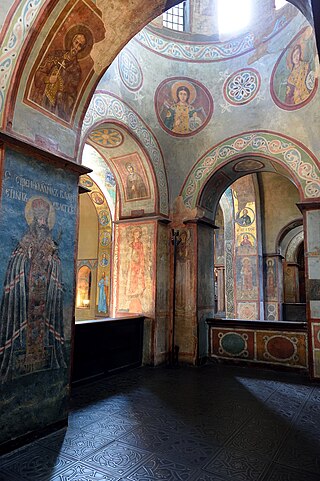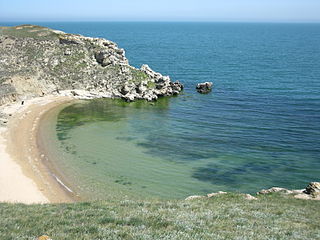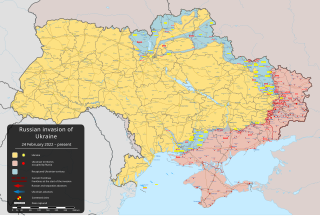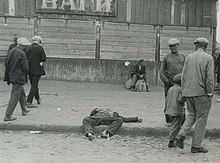
According to the United Nations, Ukraine has a population of 36,744,636 as of 2023. In July 2023, Reuters reported that due to the refugee outpouring into Western Europe, the population of Kyiv-controlled areas may have decreased to as low as 28 million. This is a steep decline from 2020, when it had a population of almost 42 million people. This is in large part due to the ongoing Ukrainian refugee crisis and loss of territory caused by Russia's invasion of Ukraine. The most recent census of a post-Soviet Ukraine occurred over 20 years ago, in 2001. Thus, much of the information presented here could be inaccurate and/or outdated.

Donetsk Oblast, also referred to as Donechchyna, is an oblast in eastern Ukraine. It is Ukraine's most populous province, with around 4.1 million residents. Its administrative centre is Donetsk, though due to the ongoing Russo-Ukrainian War, the regional administration was moved to Kramatorsk. Historically, the region has been an important part of the Donbas region. From its creation in 1938 until November 1961, it bore the name Stalino Oblast, in honour of Joseph Stalin. As part of the de-Stalinization process, it was renamed after the Siversky Donets river, the main artery of Eastern Ukraine. Its population is estimated at 4,100,280.

The Donbas or Donbass is a historical, cultural, and economic region in eastern Ukraine. Parts of the Donbas are occupied by Russia as a result of the Russo-Ukrainian War.

Crimean Tatars or Crimeans are a Turkic ethnic group and nation native to Crimea. The formation and ethnogenesis of Crimean Tatars occurred during the 13th–17th centuries, uniting Cumans, who appeared in Crimea in the 10th century, with other peoples who had inhabited Crimea since ancient times and gradually underwent Tatarization, including Greeks, Italians, Goths, Sarmatians, English and others.

Taurida Governorate was an administrative-territorial unit (guberniya) of the Russian Empire. It included the territory of the Crimean Peninsula and the mainland between the lower Dnieper River with the coasts of the Black Sea and Sea of Azov. It formed after Taurida Oblast was abolished in 1802 during the course of Paul I's administrative reform of the territories of the former Crimean Khanate which were annexed by Russia in 1783. The governorate's centre was the city of Simferopol. The name of the province was derived from Taurida, a historical name for Crimea.
Armenians in Ukraine are ethnic Armenians who live in Ukraine. They number 99,894 according to the 2001 Ukrainian census. However, the country is also host to a number of Armenian guest workers which has yet to be ascertained. The Armenian population in Ukraine has nearly doubled since the dissolution of the Soviet Union in 1989, largely due to instability in the Caucasus. Ukraine was home to the fifth largest Armenian community in the world before the invasion by Russia displaced millions of people.

Christianity is the predominant religion in Ukraine, with 85% of the population identifying as Christian according to a 2022 survey conducted by the Kyiv International Institute of Sociology (KIIS). Seventy-two percent of the population avowed fidelity to an Eastern Orthodox Church: 54% of Ukrainians proclaimed adherence to the autocephalous Orthodox Church of Ukraine; 14% identified as Orthodox Christian without specifying a church affiliation; 4% associated with the Moscow Patriarchate. Another 9% of Ukrainians professed devotion to the Catholic Church in Ukraine: 8% Ukrainian Greek Catholics and 1% Latin Catholics. Two percent of the population declared affiliation to a mainstream Protestant Church, and a further 2% identified with some alternative sect of Christianity.

Russian is the most common first language in the Donbas and Crimea regions of Ukraine and the city of Kharkiv, and the predominant language in large cities in the eastern and southern portions of the country. The usage and status of the language is the subject of political disputes. Ukrainian is the country's only state language since the adoption of the 1996 Constitution, which prohibits an official bilingual system at state level but also guarantees the free development, use and protection of Russian and other languages of national minorities. In 2017 a new Law on Education was passed which restricted the use of Russian as a language of instruction. Nevertheless, Russian remains a widely used language in Ukraine in pop culture and in informal and business communication.
Russians are the largest ethnic minority in Ukraine. This community forms the largest single Russian community outside of Russia in the world. In the 2001 Ukrainian census, 8,334,100 identified as ethnic Russians ; this is the combined figure for persons originating from outside of Ukraine and the Ukrainian-born population declaring Russian ethnicity.

Ukrainian Greeks are a Greek minority that reside in or used to reside in the territory of modern Ukraine. The majority of Ukrainian Greeks live in Donetsk Oblast and are particularly concentrated around the city of Mariupol.

Eastern Ukraine or east Ukraine is primarily the territory of Ukraine east of the Dnipro river, particularly Kharkiv, Luhansk and Donetsk oblasts (provinces). Dnipropetrovsk and Zaporizhzhia oblasts are often also regarded as "eastern Ukraine". In regard to traditional territories, the area encompasses portions of the southern Sloboda Ukraine, Donbas, the eastern Azov Littoral (Pryazovia).

Lenine Raion or Yedy-Kuiu Raion was one of the twenty-five districts of the Autonomous Republic of Crimea in Ukraine until its abolition in 2020. It continues to be used by the Russian administration known as the Republic of Crimea, as Russia has occupied Crimea since 2014.

Administrative divisions development in Ukraine reviews the history of changes in the administrative divisions of Ukraine, in chronological order.

During its existence from 1919 to 1991, the Ukrainian Soviet Socialist Republic consisted of many administrative divisions. Itself part of the highly centralized Soviet Union, sub-national divisions in the Ukrainian SSR were subordinate to higher executive authorities and derived their power from them. Throughout the Ukrainian SSR's history, other national subdivisions were established in the republic, including guberniyas and okrugs, before finally being reorganized into their present structure as oblasts. At the time of the Ukrainian SSR's independence from the Soviet Union, the country was composed of 25 oblasts (provinces) and two cities with special status, Kiev, the capital, and Sevastopol, respectively.

The Russia–Ukraine border is the de jure international boundary between Russia and Ukraine. Over land, the border spans five Russian oblasts and five Ukrainian oblasts. Due to the ongoing Russo-Ukrainian War, which began in early 2014, the de facto border between Russia and Ukraine is different from the legal border recognized by the United Nations. As of 2024, Russia is militarily occupying a significant portion of Ukraine.

From the end of February 2014, demonstrations by Russian-backed, pro-Russian, and anti-government groups took place in major cities across the eastern and southern regions of Ukraine in the aftermath of the Euromaidan and the Revolution of Dignity, which resulted in the ousting of Russian-leaning President Viktor Yanukovych. The unrest, which was supported by Russian military and intelligence, belongs to the early stages of the Russo-Ukrainian War.

The Autonomous Republic of Crimea is an administrative division of Ukraine encompassing most of Crimea that was annexed by Russia in 2014. The Autonomous Republic of Crimea occupies most of the peninsula, while the City of Sevastopol occupies the rest.
Regionalism in Ukraine has been a significant force during the building of an independent state after the dissolution of the Soviet Union in 1991. While most acutely this issue manifested itself during the 2014 pro-Russian unrest in Ukraine, other ethnic minorities in Ukraine sought for greater political or economical autonomy during 1990s. These movements, while not being secessionist, were perceived by central government as a threat to the unity of the state.

Novorossiya is a historical name, used during the era of the Russian Empire for an administrative area that would later become the southern mainland of Ukraine: the region immediately north of the Black Sea and Crimea. The province fell largely within a slightly wider area known in Ukrainian as the Stepovyna "Steppe Land", or Nyz "Lower Land". The name Novorossiya, which means New Russia, entered official usage in 1764, after the Russian Empire conquered the Crimean Khanate, and annexed its territories, when Novorossiya Governorate was founded. Official usage of the name ceased after 1917, when the entire area was incorporated in the Ukrainian People's Republic.

The following outline is provided as an overview of and topical guide to the Russo-Ukrainian War:


















